

Questioning Smore. Coffee Cups and Lesson Plans: Reading Comprehension with Bloom Balls. During the school year we read Flying Solo by Ralph Fletcher.
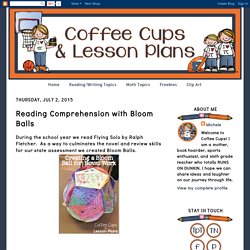
The Blooming Orange. I've always been interested in new ways to view and think about Bloom's Taxonomy and the folks at Learning Today have created a poster worth sharing.
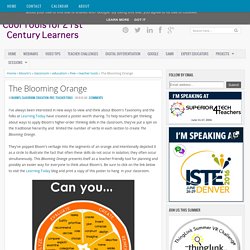
To help teachers get thinking about ways to apply Bloom's higher-order thinking skills in the classroom, they've put a spin on the traditional hierarchy and limited the number of verbs in each section to create The Blooming Orange. They've popped Bloom's verbage into the segments of an orange and intentionally depicted it as a circle to illustrate the fact that often these skills do not occur in isolation, they often occur simultaneously. This Blooming Orange presents itself as a teacher-friendly tool for planning and possibly an easier way for everyone to think about Bloom's. Be sure to click on the link below to visit the Learning Today blog and print a copy of this poster to hang in your classroom. Bloom Stem Questions. Writing Objectives Using Bloom's Taxonomy. Various researchers have summarized how to use Bloom’s Taxonomy.
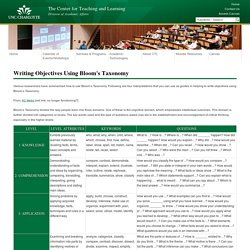
Following are four interpretations that you can use as guides in helping to write objectives using Bloom’s Taxonomy. From: KC Metro [old link, no longer functioning?] Bloom’s Taxonomy divides the way people learn into three domains. One of these is the cognitive domain, which emphasizes intellectual outcomes. This domain is further divided into categories or levels. Bloom’s Taxonomy. Background Information | The Original Taxonomy | The Revised Taxonomy | Why Use Bloom’s Taxonomy? | Further Information The above graphic is released under a Creative Commons Attribution license. You’re free to share, reproduce, or otherwise use it, as long as you attribute it to the Vanderbilt University Center for Teaching.
For a higher resolution version, visit our Flickr account and look for the “Download this photo” icon. Background Information In 1956, Benjamin Bloom with collaborators Max Englehart, Edward Furst, Walter Hill, and David Krathwohl published a framework for categorizing educational goals: Taxonomy of Educational Objectives. The framework elaborated by Bloom and his collaborators consisted of six major categories: Knowledge, Comprehension, Application, Analysis, Synthesis, and Evaluation.
The Original Taxonomy (1956) Here are the authors’ brief explanations of these main categories in from the appendix of Taxonomy of Educational Objectives (Handbook One, pp. 201-207): Question-Answer Relationship (QAR) 1.
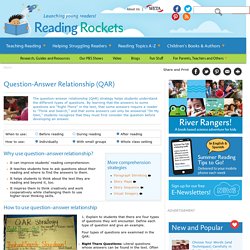
Explain to students that there are four types of questions they will encounter. Define each type of question and give an example. Four types of questions are examined in the QAR: Right There Questions: Literal questions whose answers can be found in the text. Often the words used in the question are the same words found in the text. 2. 3. HOTS-Question-Cards-821485 Teaching Resources. <div class="deployment_message_block"><span> Hi, You need to enable javascript on your browser to use TpT.
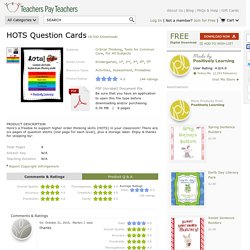
<a href=" target="_blank">See how this improves your TpT experience</a>. </span></div> About Us | Blog | FAQs & Help | Gift Cards All Categories Cart Your shopping cart is empty. Meet The Blooms Bunch: How I Increased My Students Higher-Order Thinking Skills using Characters for Revised Bloom's Taxonomy. As a newer teacher I find myself always looking up which questions/activities fall under what level of higher-order thinking.

While looking up action verbs for each level of thinking I would find repeating verbs in multiple levels and I think things like, "Ok, so is comparing ideas analyzing or evaluating? " I got so tired of being confused that I borrowed these two books from a small collection of teacher resource books at my school before I headed off to Spring Break. (Yes, I know I'm a nerd). I now have a better understanding of the Revised Bloom's Taxonomy, but I felt like I needed a cheat sheet that was directly from the source. That is how The Blooms Family was created. Meet Christie the Creator, Evan the Evaluator, Anna the Analyzer. 38 Question Starters based on Bloom’s Taxonomy - Curriculet.
Curriculet is free for teachers and students.
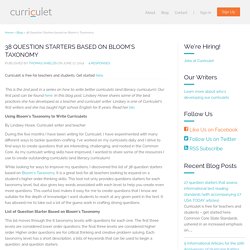
Get started here. This is the 2nd post in a series on how to write better curriculets (and literacy curriculum). Our first post can be found here. In this blog post, Lindsey Howe shares some of the best practices she has developed as a teacher and curriculet writer. Lindsey is one of Curriculet’s first writers and she has taught high school English for 8 years. New Blooms. 25 Question Stems Framed Around Bloom's Taxonomy. 25 Question Stems Framed Around Bloom’s Taxonomy While critical thinking is a foundation rather than a brick, how you build that foundation depends on the learning process itself: exposing students to new thinking and promoting interaction with that thinking in a gradual release of responsibility approach.

Question stems can be a powerful part of that process no matter where the learner is. Assessment (pre-assessment, self-assessment, formative and summative assessment), prompting and cueing during discussion, etc. Common Core Standards. M1-Slide_22_DOK_Hess_Cognitive_Rigor.pdf. Webbs-Depth-of-Knowledge-DOK-Explained-in-Plain-English.jpg (JPEG Image, 3029 × 2267 pixels) - Scaled (33%) Dok_bloom.pdf. DOK_Chart.jpg (JPEG Image, 1700 × 2200 pixels) - Scaled (45%)